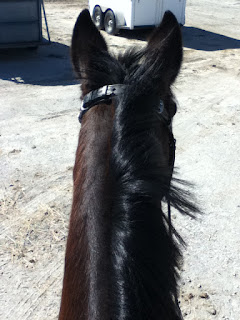I haven't blogged about Pangea in nearly a month. A MONTH! Mostly I've had little to write about, honestly - I've been working insanely long hours at my two full time jobs as well as trying desperately to keep up with full time school (yes, three full time things plus riding doesn't work out very well) - and I haven't been riding very much due to the heat and Pangea's inability to cope with it. She's been doing a lot better, thankfully, but she has struggled over the past few months to keep herself cool. Lots and lots of sweat and one sunbleached coat later, and we seem to be reaching the end of summer, sort of. As I write, it is currently overcast and 68 degrees. I know it will warm into the low 90's later today, but I'll take that as "cooling off." We're not supposed to reach into the 100's again in the foreseeable future, so I am hoping it won't happen again until next summer!
Most of what Pangea has done over the past month is nothing at all, save for going in the AquaTread once a week, a few dressage rides, and a few trail rides as well. She is still teetering on the edge of comfortable enough to be strongly rideable, and I have been debating whether or not to really pursue a foxhunting career with her. Is she going to stay comfortably sound enough to do it, or not? I figure I will keep trying to find her magic combination for the rest of the year, and then reevaluate. To be honest, if she isn't going to make a foxhunter, then she'll be semi-retired and become a happy trail pony and momma. I don't want to hear ONE NEGATIVE WORD from people about her being a momma. I've made the mistake of talking about breeding in the past, and I am not keen to get the same negative response. My horse, my money, my decision, end of story! ;)
Anyway, back to Pangea's comfort. As her issues have unfolded, I have realized they are far more complicated than I ever imagined. It isn't just that she had an old stifle injury that was unattended to, it was that her entire body has been compensating for years due to that and her feet. The soreness in her body made her stand in odd positions - camped under a lot in front, for instance - which in turn made her wear her sole thin at the toe and grow a long heel... which made her body sore. Her entire body developed a sway to the right, feet included. We have come a VERY long way in helping to improve her posture, but she is still very body sore and restricted. Two chiropractic adjustments have failed to help her, and dental work didn't improve anything either. (I thought the dentist was great but the chiro was not great... we'll be looking for a new one.) Regular trims and a balanced diet have done an awful lot of good for her feet, but she is going to need boots if we want to get any further on tougher terrain. Devil's Claw Plus and Cosequin ASU were very helpful, but not quite enough. She is currently going through a course of Acetyl-D, and if that isn't helpful enough, will do a course of Adequan as well. She had a massage yesterday for the first time, as I suspected it would do her a whole lot of good, and holy lord did she ever need it! She spent the entire time trying to bite me and kicking out violently at all the knots the massage therapist uncovered. As she's not a biter or a kicker, it speaks an awful lot about the level of pain she was feeling. (At least she wasn't trying to kick the massage therapist... she was just kicking out backwards to show how she really felt about the whole thing, instead of aiming for her!) She was stuck basically from head to tail, poor thing. It's all compensatory soreness... it's all just a big mess. She'll get another one next week, and we'll see how she feels then.
The saddest part about this whole ordeal is that had somebody bothered to properly treat her injury when it first happened, none of this would be happening now. Now, it is up to me to play clean-up crew, and it isn't pretty. Truthfully, she doesn't owe me anything, and if I can't get her to where she needs to be to be a consistent riding horse, then she'll be retired to broodie and trail duty. There isn't anything that she has to do for me in order to earn her keep. Just being who she is is enough for me.
A few of the things we've been up to this past month:








Also, systematically destroying flymasks. She is very good at that.
A few shreds at first...

... to the full Phantom of the Opera.

No more nice Cashel masks for you mare... this is the fourth one you have destroyed this summer!! She wore the one Gogo had for FIVE YEARS for three days and completely ruined it. She also blew through a Quiet Ride mask and now TWO more regular Cashel masks, one with ears and one without... fail! I hear Horseman's has super cheap masks with durable mesh... gonna have to check them out for sure.
We'll see how the massage worked!














